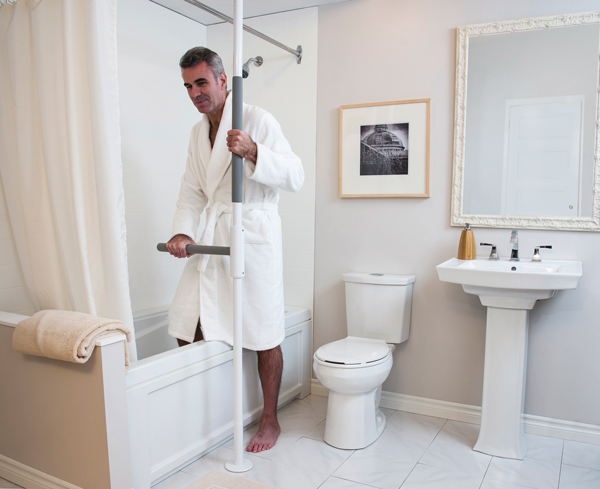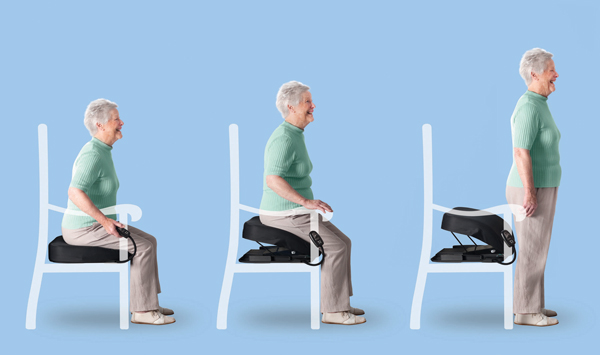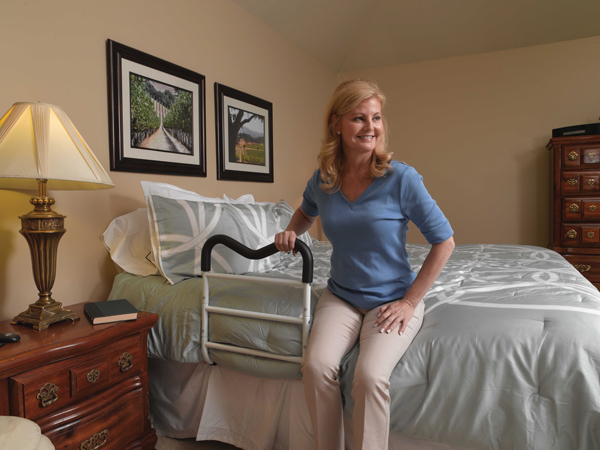About 30 percent of adults over 65 fall each year. Hospital emergency rooms see 2.4 million nonfatal injuries in the elderly, and more than 689,000 of these patients are hospitalized. These trends are clear indicators of the growth in business home medical equipment providers can achieve in the fall prevention sector. Educating consumers about what's available is key to success.
Ian Crawford
HealthCraft Products www.healthcraftproducts.com
 The Super Pole with Super Bar provides bi-directional support.
The Super Pole with Super Bar provides bi-directional support.
HC: What trends do you see on the horizon in the fall prevention industry market this year?
IC: Aging-in-place is a market trend that is affecting many industries. DME retailers and installers deal with an aging population each day, but major trade associations are also training their members to work with an aging population. For example, the National Association of Home Builders (NAHB) offers a Certified Aging in Place Specialist (CAPS) program.
HC: What challenges do you anticipate this year?
IC: A challenge in the DME industry is that some retailers only view themselves as a supply house. They don't fully maximize their product knowledge and expertise because they compete only on price. Offering just the basic commodity and price-driven items that a consumer asks for really limits sales potential.
HC: What is the most important thing that HME providers can do to stay competitive in this market?
IC: We have to understand that a lower price does come at a cost, but by having a full product selection and a suggestive sales process, we can allow customers to make a better cost vs. value decision. By offering items beyond the standard, we further separate ourselves from the pack as the experts.
Laura Casto
Carex Health Brands www.carex.com
 The Uplift Premium Power Seat lifts without pushing user forward.
The Uplift Premium Power Seat lifts without pushing user forward.
HC: What trends do you see on the horizon in the fall prevention industry market this year?
LC: We are continuing to see the development of traditional fall prevention products like canes, walkers and grab bars, but we are noticing that each advancement features newer accommodations that match the lifestyle, aesthetic desires and general needs of today's senior citizens, empowering them to be independent and feel safe in every room of their homes.
HC: What challenges do you anticipate this year?
LC: Our biggest challenge as a manufacturer first lies in the ability to determine where and how these falls are still occurring then working to develop innovative solutions that further minimizes a consumer's risk of falling. From a provider's perspective, we believe lower reimbursements will lead to dealers offering less reimbursable items and increasing their product assortment of retail/cash sale items.
HC: What is the most important thing that HME providers can do to stay competitive in this market?
LC: Having a fall prevention area in a showroom can help educate seniors and their family members on the available product options and how they are installed, and helps to easily translate the benefits. It also allows seniors to try product out and determine what suits them best.
Derek Lampert
Drive Medical Design & Mfg. www.drivemedical.com
 No-drill grab bars provide high-end style and non-invasive installation.
No-drill grab bars provide high-end style and non-invasive installation.
HC: What trends do you see on the horizon in the fall prevention industry market this year?
DL: Like all market trends, consumers want products with more current form and function. They want to feel like they just had a high-end retail shopping experience. You will continue to see improvements in packaging and marketing will be targeted to the caregiver vs. the consumer. Fall prevention products are moving towards a less institutional look and the baby boomers are creating more demand for "best" versions in the good, better, best lineup.
HC: What challenges do you anticipate this year?
DL: Fall prevention starts with education and assessment. The items themselves are the perfect complement to reimbursement reductions as the majority fall into the cash retail classification. The irony is that the provider reaction to reimbursement reductions has been to spend less time in patient homes and this is the primary environment where fall prevention can be facilitated.
HC: What is the most important thing that HME providers can do to stay competitive in this market?
DL: Teaching is the new selling. HME providers need to brand themselves as something far greater than a delivery service. They need to bring education into the home, and that requires them to slow down during delivery and start conducting fall prevention assessments. Only then can a provider properly advise on what items would be appropriate for a consumer's plan of care. If providers start to brand themselves as trusted advisors, consumers will look to them for all of their lifetime of medical equipment needs.




